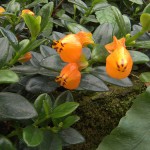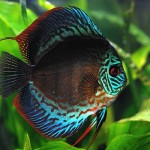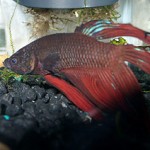There many kinds of algae in aquariums, but the two main kinds are 1) brown algae and 2) green algae.
1) Brown algae This algae mainly consist of diatoms, a microscopic one-celled alga that has silica-filled cell walls or shells divided into two halves; single-celled microscopic algae. These grow and form a thin film on the decorations and the glass of the aquarium tank.
2) Green algae It is generally that cloudy green gunk in an aquarium. It is the result of having too much light and dissolved waste in the water or when the concentration of nutritional elements (mineral salts), particularly nitrogen, is too high, in strong light.
There are some ecological methods to solving an algae problem. Try to regulate the factor aggravating the algae overgrowth by adjusting the amount of light. Too much light will cause green algae to grow at a greater rate. If a tank is too warm, algae will also grow. The warmth does not make for a dynamic aquarium. By changing the position of the tubes, or the addition of deflectors, to keep algae off the front of the tank, produces good results. In freshwater aquariums, you can make partial water changes, on a fairly regular basis, using water with a low hardness containing few mineral salts. Sometimes, and unfortunately, the multiplying of algae can be so extensive that the only option is to create a whole new aquarium from scratch.
There are also biological methods to combat algae growth. These can involve the use of plant-eating Fish such as the Plecostomus, “suckerfish”. This fish is an algae eateronly interested in certain types of algae. Also, use the Epalzeorhynchus against algae in fresh water: This algae eater is often called king of the algae eaters and is also known as the Siamese algae eater. Siamese algae eaters are not very demanding. Water should be clean and oxygenated, because they come from bright and fast-flowing streams. Siamese algae eaters eat the algae, including red algae. It is unusual to find a spread of red algae in an aquarium.They haven’t yet been bred in captivity, so all the specimens are caught from nature. It appears that the fish are seasonal and are not always available in shops. Minimum tank size for a pair of adult Siamese Algae Eaters is 100 liters (25 gallons). The aquarium should have lots of living plants.
There are chemical methods to kill algae. There are special products on the market designed to kill algae. As their effect has not been fully established, it is best to be cautious with the dosage, as these substances will probably affect other plants. For the same reasons, the use of copper sulfate is not recommended, as it is dangerous for invertebrates, those without a backbone. There is no miracle solution. The use of several techniques at the same time sometimes has the greatest results, but it is not at all uncommon to find that the algae reappear after a while. It is best to get used to partially removing them on a regular basis. Remember, to cut back on the light, do 10 percent water changes daily until the algae clears up and purchase algae eating fish such as Siamese algae eaters.

Lastly, there is the mechanical method of controlling algae. Algae can be removed by hand, by sliding the leaves of the plant between the thumb and index figure, by rolling slender strands of algae around a stick, or, with a scraper equipped with a razor blade and or a small scouring pad. Any rocks, sand, coral skeletons, branches, or roots contaminated by algae can be treated, outside the aquarium, in a 10% bleach solution, to which these algae are very sensitive. Any underwater equipment populated by algae (heating, pipes, diffuser, filter) can be treated in the same way. It is important to rinse and dry them thoroughly before putting them back into the tank. Sometimes, however, the increase of algae can be so extensive that once, again, the only option is to create a whole new aquarium system. It is best not to let it get to this level of thickness. Any algae are an eyesore in the home aquarium. Excess algae grow on the panes, reducing the visibility. They attach themselves to plants and multiply, with the ensuing risk of suffocating their hosts, as the plants are prevented from exchanging gases and absorbing the salts in the water. Finally, they coat themselves on the aquarium decor, which does nothing to enhance the visual beauty of the tank. In this case an ounce of prevention is worth a pound of cure.

















thank you so much this is very useful…….and having doubts about Fish tan somebody help me to clear it
my fish tank is dirty so thank you
Very educative